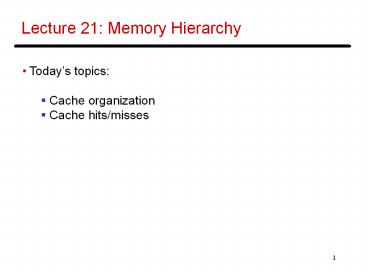Lecture 21: Memory Hierarchy - PowerPoint PPT Presentation
Title:
Lecture 21: Memory Hierarchy
Description:
Lecture 21: Memory Hierarchy Today s topics: Cache organization Cache hits/misses * * Memory Hierarchy As you go further, capacity and latency increase Registers ... – PowerPoint PPT presentation
Number of Views:97
Avg rating:3.0/5.0
Title: Lecture 21: Memory Hierarchy
1
Lecture 21 Memory Hierarchy
- Todays topics
- Cache organization
- Cache hits/misses
2
Memory Hierarchy
- As you go further, capacity and latency increase
Disk 80 GB 10M cycles
Memory 1GB 300 cycles
L2 cache 2MB 15 cycles
L1 data or instruction Cache 32KB 2 cycles
Registers 1KB 1 cycle
3
Accessing the Cache
Byte address
101000
Offset
8-byte words
8 words 3 index bits
Direct-mapped cache each address maps to a
unique address
Sets
Data array
4
The Tag Array
Byte address
101000
Tag
8-byte words
Compare
Direct-mapped cache each address maps to a
unique address
Data array
Tag array
5
Example Access Pattern
Byte address
Assume that addresses are 8 bits long How many of
the following address requests are
hits/misses? 4, 7, 10, 13, 16, 68, 73, 78, 83,
88, 4, 7, 10
101000
Tag
8-byte words
Compare
Direct-mapped cache each address maps to a
unique address
Data array
Tag array
6
Increasing Line Size
Byte address
A large cache line size ? smaller tag
array, fewer misses because of spatial locality
10100000
32-byte cache line size or block size
Tag
Offset
Data array
Tag array
7
Associativity
Byte address
Set associativity ? fewer conflicts wasted
power because multiple data and tags are read
10100000
Tag
Way-1
Way-2
Data array
Tag array
Compare
8
Associativity
How many offset/index/tag bits if the cache
has 64 sets, each set has 64 bytes, 4 ways
Byte address
10100000
Tag
Way-1
Way-2
Data array
Tag array
Compare
9
Example
- 32 KB 4-way set-associative data cache array
with 32 - byte line sizes
- How many sets?
- How many index bits, offset bits, tag bits?
- How large is the tag array?
10
Cache Misses
- On a write miss, you may either choose to bring
the block - into the cache (write-allocate) or not
(write-no-allocate) - On a read miss, you always bring the block in
(spatial and - temporal locality) but which block do you
replace? - no choice for a direct-mapped cache
- randomly pick one of the ways to replace
- replace the way that was least-recently used
(LRU) - FIFO replacement (round-robin)
11
Writes
- When you write into a block, do you also update
the - copy in L2?
- write-through every write to L1 ? write to L2
- write-back mark the block as dirty, when the
block - gets replaced from L1, write it to L2
- Writeback coalesces multiple writes to an L1
block into one - L2 write
- Writethrough simplifies coherency protocols in a
- multiprocessor system as the L2 always has a
current - copy of data
12
Types of Cache Misses
- Compulsory misses happens the first time a
memory - word is accessed the misses for an infinite
cache - Capacity misses happens because the program
touched - many other words before re-touching the same
word the - misses for a fully-associative cache
- Conflict misses happens because two words map
to the - same location in the cache the misses
generated while - moving from a fully-associative to a
direct-mapped cache
13
Title
- Bullet































